Ag3PO4/Bi2WO6 Heterojunction Photocatalyst with Remarkable Visible-Light-Driven Catalytic Activity
Abstract
:1. Introduction
2. Materials and Methods
2.1. Reagents and Materials
2.2. Preparation of Photocatalysts
2.3. Characterization
2.4. Activity Test
2.5. Calculation
3. Results and Discussion
3.1. Physicochemical Structure
3.2. Photocatalytic Performance under Visible-Light Irradiation
3.3. The Relationship of Structure and Activity
3.3.1. Main Free Radicals
3.3.2. PL Analysis
3.3.3. EIS Analysis
3.3.4. DFT Analysis
3.3.5. Proposed Photocatalytic Degradation Mechanism
4. Conclusions
Supplementary Materials
Author Contributions
Funding
Data Availability Statement
Acknowledgments
Conflicts of Interest
References
- Schipper, D.E.; Zhao, Z.; Leitner, A.P.; Xie, L.; Qin, F.; Alam, M.K.; Chen, S.; Wang, D.; Ren, Z.; Wang, Z.; et al. A TiO2/FeMnP core/shell nanorod array photoanode for efficient photoelectrochemical oxygen evolution. ACS Nano 2017, 11, 4051–4059. [Google Scholar] [CrossRef]
- Li, S.J.; Hu, S.W.; Jiang, W.; Liu, Y.; Liu, J.S.; Wang, Z.H. Facile synthesis of flower-like Ag3VO4/Bi2WO6 heterojunction with enhanced visible-light photocatalytic activity. J. Colloid Interface Sci. 2017, 501, 156–163. [Google Scholar] [CrossRef]
- Meng, F.P.; Liu, Y.Z.; Wang, J.; Tan, X.Y.; Sun, H.Q.; Liu, S.M.; Wang, S.B. Temperature dependent photocatalysis of g-C3N4, TiO2 and ZnO: Differences in photoactive mechanism. J. Colloid Interface Sci. 2018, 532, 321–330. [Google Scholar] [CrossRef]
- Yao, L.Z.; Wang, W.Z.; Wang, L.J.; Liang, Y.J.; Fu, J.L.; Shi, H.L. Chemical bath deposition synthesis of TiO2/Cu2O core/shell nanowire arrays with enhanced photoelectrochemical water splitting for H2 evolution and photostability. Int. J. Hydrogen Energy 2018, 43, 15907–15917. [Google Scholar] [CrossRef]
- Kosemen, A.; Kosemen, Z.A.; Canimkubey, B.; Erkovan, M.; Basarir, F.; San, S.E.; Ornek, O.; Tunc, A.V. Fe doped TiO2 thin film as electron selective layer for inverted solar cells. Sol. Energy 2016, 132, 511–517. [Google Scholar] [CrossRef]
- Zhang, F.J.; Zhu, S.F.; Xie, F.Z.; Zhang, J.; Meng, Z.D. Plate-on-plate structured Bi2MoO6/Bi2WO6 heterojunction with high-efficiently gradient charge transfer for decolorization of MB. Sep. Purif. Technol. 2013, 113, 1–8. [Google Scholar] [CrossRef]
- Zhang, Y.H.; Zhang, N.; Tang, Z.R.; Xu, Y.J. Identification of Bi2WO6 as a highly selective visible-light photocatalyst toward oxidation of glycerol to dihydroxyacetone in water. Chem. Sci. 2013, 4, 1820–1824. [Google Scholar] [CrossRef]
- Hill, J.C.; Choi, K.S. Synthesis and characterization of high surface area CuWO4 and Bi2WO6 electrodes for use as photoanodes for solar water oxidation. J. Mater. Chem. A 2013, 1, 5006–5014. [Google Scholar] [CrossRef]
- Zhang, Z.M.; Jiang, X.; Mei, J.F.; Li, Y.X.; Han, W.H.; Xie, M.Z.; Wang, F.C.; Xie, E.Q. Improved photoelectrocatalytic hydrogen generation through BiVO4 quantum-dots loaded on nano-structured SnO2 and modified with carbon quantum-dots. Chem. Eng. J. 2018, 331, 48–53. [Google Scholar] [CrossRef]
- Nualkaew, P.; Phuruangrat, A.; Dumrongrojthanath, P.; Thongtem, S.; Thongtem, T. Synthesis of Ag3VO4 nanoparticles loaded on Bi2MoO6 nanoplates as heterostructure visible light driven photocatalyst by sonochemical method. J. Ceram. Soc. Jpn. 2016, 124, 1157–1160. [Google Scholar] [CrossRef]
- Kumar, S.; Surendar, T.; Baruah, A.; Shanker, V. Synthesis of a novel and stable g-C3N4-Ag3PO4 hybrid nanocomposite photocatalyst and study of the photocatalytic activity under visible light irradiation. J. Mater. Chem. A 2013, 1, 5333–5340. [Google Scholar] [CrossRef]
- Yan, Q.S.; Li, C.; Lin, C.P.; Zhao, Y.L.; Zhang, M.H. Visible light response AgBr/Ag3PO4 hybrid for removal of anionic dye and tetracycline hydrochloride in water. J. Mater. Sci. Mater. Electron. 2018, 29, 2517–2524. [Google Scholar] [CrossRef]
- Qiao, R.; Mao, M.; Hu, E.; Zhong, Y.; Ning, J.; Hu, Y. Facile formation of mesoporous BiVO4/Ag/AgCl heterostructured microspheres with enhanced visible-light photoactivity. Inorg. Chem. 2015, 54, 9033–9039. [Google Scholar] [CrossRef] [PubMed]
- Mei, F.F.; Dai, K.; Zhang, J.F.; Li, W.Y.; Liang, C.H. Construction of Ag SPR-promoted step-scheme porous g-C3N4/Ag3VO4 heterojunction for improving photocatalytic activity. Appl. Surf. Sci. 2019, 488, 151–160. [Google Scholar] [CrossRef]
- Zhou, Y.G.; Zhang, Y.F.; Lin, M.S.; Long, J.L.; Zhang, Z.Z.; Lin, H.X.; Wu, J.C.S.; Wang, X.X. Monolayered Bi2WO6 nanosheets mimicking heterojunction interface with open surfaces for photocatalysis. Nat. Commun. 2015, 6, 8340. [Google Scholar] [CrossRef]
- Qiu, L.Y.; Cui, Y.M.; Tan, X.Y.; Zheng, S.X.; Zhang, H.; Xu, J.W.; Wang, Q.Y. Construction of Ag3PO4/Ag4P2O7 nanospheres sensitized hierarchical titanium dioxide nanotube mesh for photoelectrocatalytic degradation of methylene blue. Sep. Purif. Technol. 2019, 215, 619–624. [Google Scholar] [CrossRef]
- Vattikuti, S.V.P.; Zeng, J.; Ramaraghavulu, R.; Shim, J.; Mauger, A.; Julien, C.M. High-Throughput Strategies for the Design, Discovery, and Analysis of Bismuth-Based Photocatalysts. Int. J. Mol. Sci. 2022, 24, 663. [Google Scholar] [CrossRef]
- Wang, R.; Xu, M.; Xie, J.W.; Ye, S.Y.; Song, X.L. A spherical TiO2-Bi2WO6 composite photocatalyst for visible-light photocatalytic degradation of ethylene. Colloid Surface A 2020, 602, 125048. [Google Scholar] [CrossRef]
- Huang, C.; Chen, L.; Li, H.; Mu, Y.; Yang, Z. Synthesis and application of Bi2WO6 for the photocatalytic degradation of two typical fluoroquinolones under visible light irradiation. RSC Adv. 2019, 9, 27768–27779. [Google Scholar] [CrossRef]
- Wang, J.J.; Tang, L.; Zeng, G.M.; Deng, Y.C.; Liu, Y.N.; Wang, L.G.; Zhou, Y.Y.; Guo, Z.; Wang, J.J.; Zhang, C. Atomic scale g-C3N4/Bi2WO6 2D/2D heterojunction with enhanced photocatalytic degradation of ibuprofen under visible light irradiation. Appl. Catal. B Environ. 2017, 209, 285–294. [Google Scholar] [CrossRef]
- Lu, X.Y.; Che, W.J.; Hu, X.F.; Wang, Y.; Zhang, A.T.; Deng, F.; Luo, S.L.; Dionysiou, D.D. The facile fabrication of novel visible-light-driven Z-scheme CuInS2/Bi2WO6 heterojunction with intimate interface contact by in situ hydrothermal growth strategy for extraordinary photocatalytic performance. Chem. Eng. J. 2019, 356, 819–829. [Google Scholar] [CrossRef]
- Ma, F.Y.; Yang, Q.L.; Wang, Z.J.; Liu, Y.H.; Xin, J.J.; Zhang, J.J.; Hao, Y.T.; Li, L. Enhanced visible-light photocatalytic activity and photostability of Ag3PO4/Bi2WO6 heterostructures toward organic pollutant degradation and plasmonic Z-scheme mechanism. RSC Adv. 2018, 8, 15853–15862. [Google Scholar] [CrossRef] [PubMed]
- Chen, X.J.; Dai, Y.Z.; Wang, X.Y. Methods and mechanism for improvement of photocatalytic activity and stability of Ag3PO4: A review. J. Alloys Compd. 2015, 649, 910–932. [Google Scholar] [CrossRef]
- Jonjana, S.; Phuruangrat, A.; Thongtem, T.; Kuntalue, B.; Thongtem, S. Decolorization of rhodamine B photocatalyzed by Ag3PO4/Bi2WO6 nanocomposites under visible radiation. Mater. Lett. 2018, 218, 146–149. [Google Scholar] [CrossRef]
- Ma, P.Y.; Yu, Y.; Xie, J.J.; Fu, Z.Y. Ag3PO4/CuO composites utilizing the synergistic effect of photocatalysis and Fenton-like catalysis to dispose organic pollutants. Adv. Powder Technol. 2017, 28, 2797–2804. [Google Scholar] [CrossRef]
- Zheng, C.X.; Yang, H. Assembly of Ag3PO4 nanoparticles on rose flower-like Bi2WO6 hierarchical architectures for achieving high photocatalytic performance. J. Mater. Sci. Mater. Electron. 2018, 29, 9291–9300. [Google Scholar] [CrossRef]
- Amiri, M.; Dashtian, K.; Ghaedi, M.; Mosleh, S.; Jannesar, R. Bi2WO6/Ag3PO4-Ag Z-scheme heterojunction as a new plasmonic visible-light-driven photocatalyst: Performance evaluation and mechanism study. New J. Chem. 2019, 43, 1275–1284. [Google Scholar] [CrossRef]
- Qian, X.F.; Yue, D.T.; Tian, Z.Y.; Reng, M.; Zhu, Y.; Kan, M.; Zhang, T.Y.; Zhao, Y.X. Carbon quantum dots decorated Bi2WO6 nanocomposite with enhanced photocatalytic oxidation activity for VOCs. Appl. Catal. B Environ. 2016, 193, 16–21. [Google Scholar] [CrossRef]
- Hou, G.Q.; Zeng, X.F.; Gao, S.J. Fabrication and photocatalytic activity of core@shell Ag3PO4@Cu2O heterojunction. Mater. Lett. 2019, 238, 116–120. [Google Scholar] [CrossRef]
- Chi, C.Y.; Pan, J.Q.; You, M.Z.; Dong, Z.J.; Zhao, W.J.; Song, C.S.; Zheng, Y.Y.; Li, C.R. The porous TiO2 nanotubes/Ag3PO4 heterojunction for enhancing sunlight photocatalytic activity. J. Phys. Chem. Solids 2018, 114, 173–178. [Google Scholar] [CrossRef]
- Zhang, F.J.; Sun, R.; Li, R.S.; Song, N.N.; Feng, L.M.; Zhong, S.; Zhao, Z.Q. Novel La-doped Bi2WO6 photocatalysts with enhanced visible-light photocatalytic activity. J. Sol-Gel Sci. Technol. 2018, 86, 640–649. [Google Scholar] [CrossRef]
- Zhang, J.L.; Ma, Z. Ag3VO4/AgI composites for photocatalytic degradation of dyes and tetracycline hydrochloride under visible light. Mater. Lett. 2018, 216, 216–219. [Google Scholar] [CrossRef]
- Liu, Y.; Wang, W.G.; Si, M.Z.; Yu, Y.F.; Zhang, H.Y. (Yb3+, Er3+) co-doped TiO2/Ag3PO4 hybrid photocatalyst with enhanced activity for photodegradation of phenol. Appl. Surf. Sci. 2019, 463, 159–168. [Google Scholar] [CrossRef]
- Tian, L.; Xian, X.Z.; Cui, X.K.; Tang, H.; Yang, X.F. Fabrication of modified g-C3N4 nanorod/Ag3PO4 nanocomposites for solar-driven photocatalytic oxygen evolution from water splitting. Appl. Surf. Sci. 2018, 430, 301–308. [Google Scholar] [CrossRef]
- Shen, Y.Z.; Zhu, Z.D.; Wang, X.G.; Khan, A.; Gong, J.Y.; Zhang, Y.R. Synthesis of Z-scheme g-C3N4/Ag/Ag3PO4 composite for enhanced photocatalytic degradation of phenol and selective oxidation of gaseous isopropanol. Mater. Res. Bull. 2018, 107, 407–415. [Google Scholar] [CrossRef]
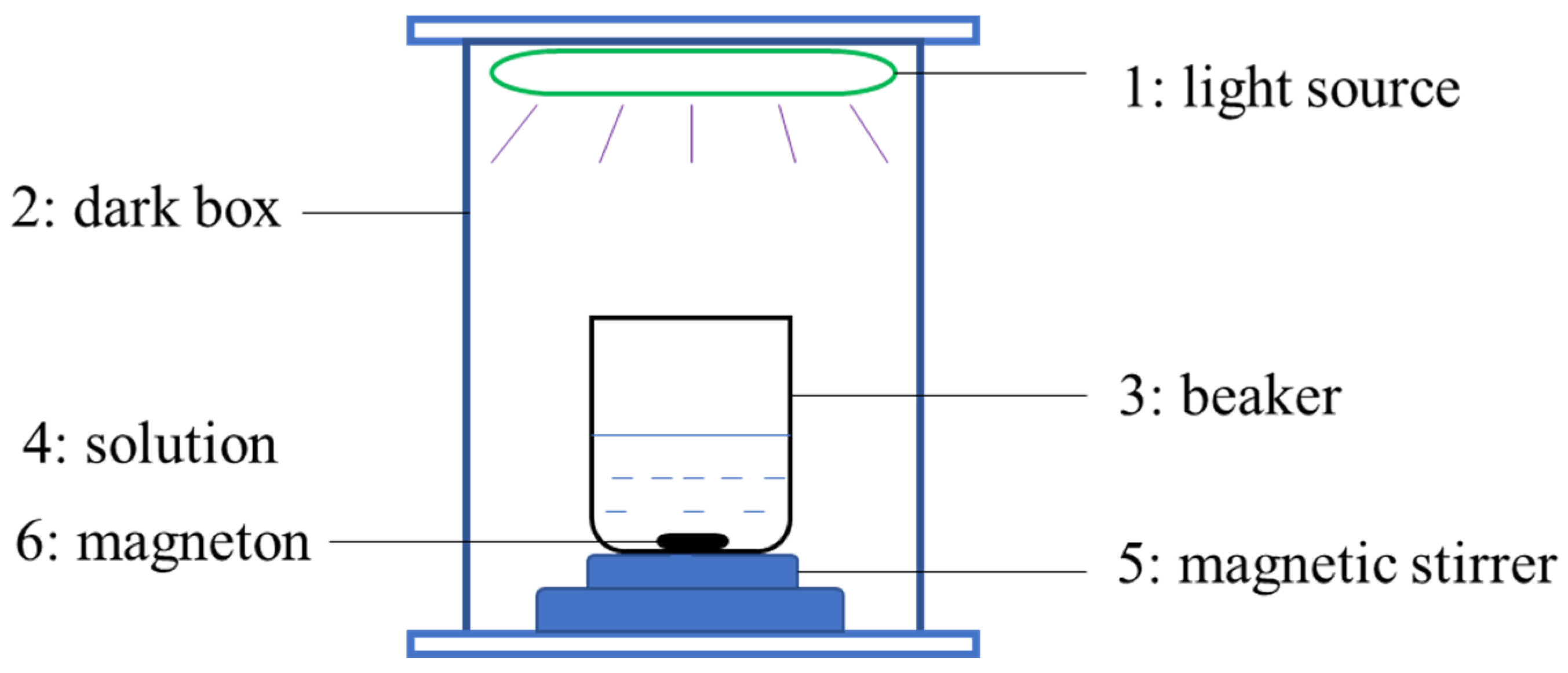
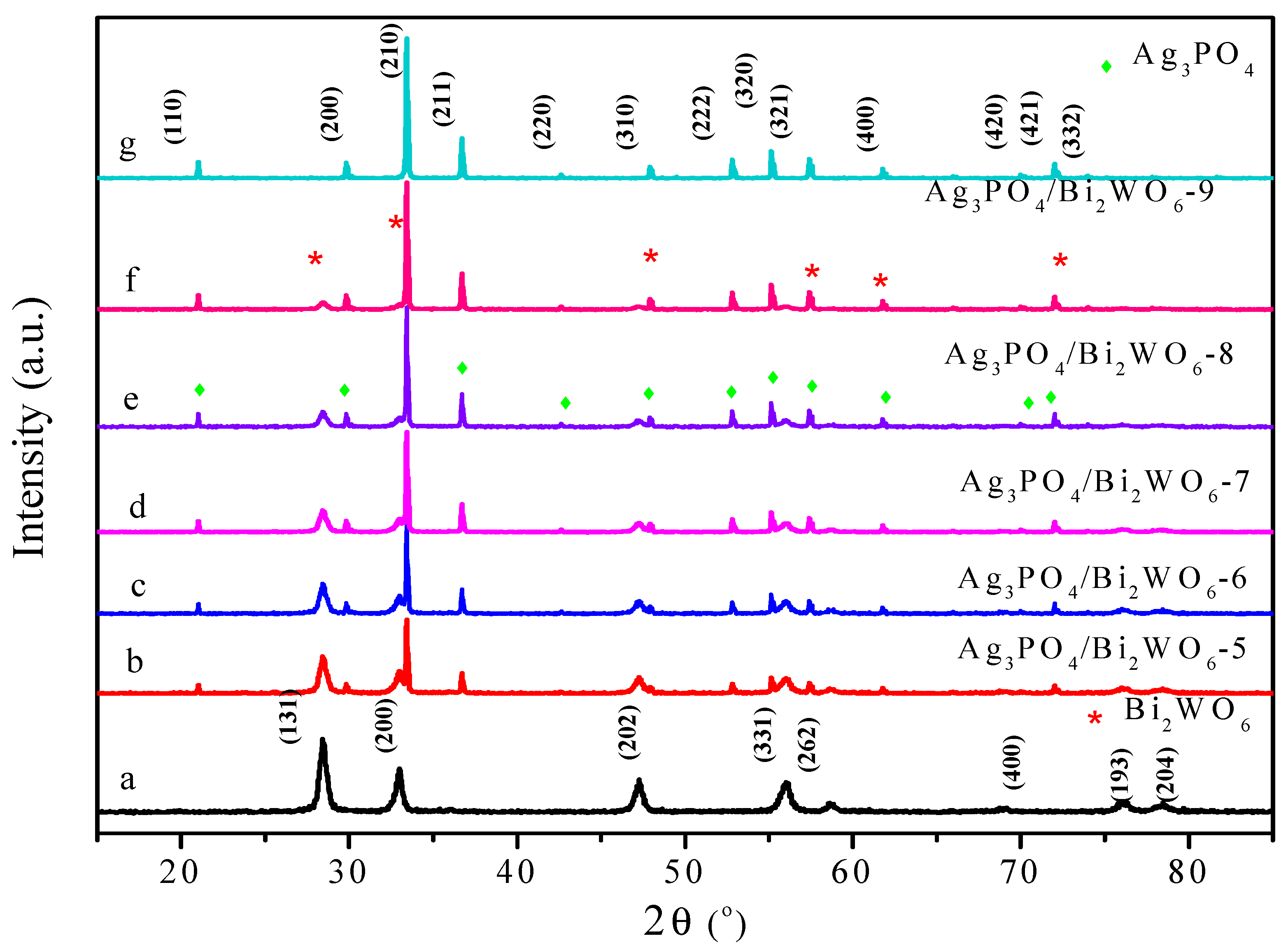
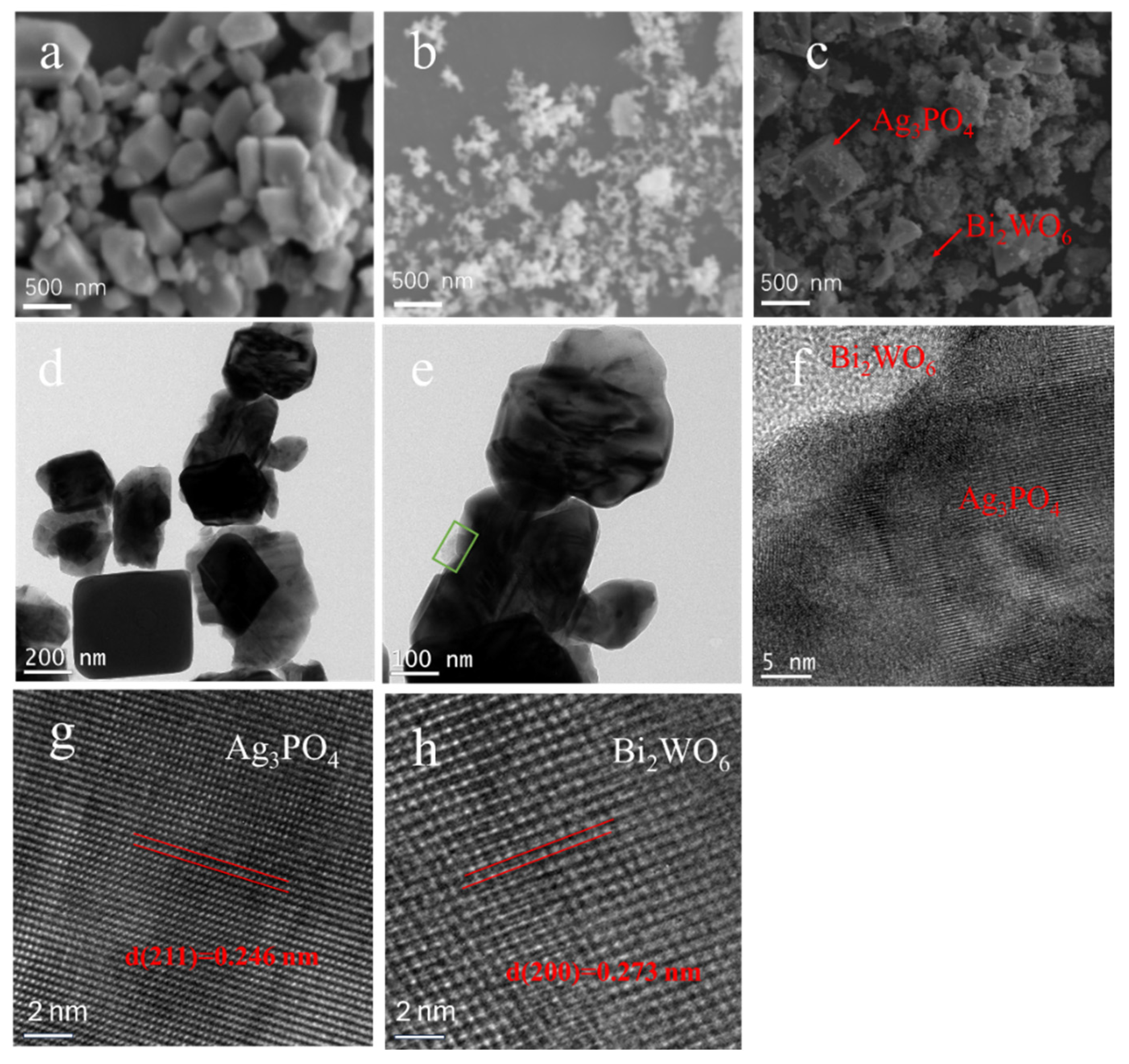
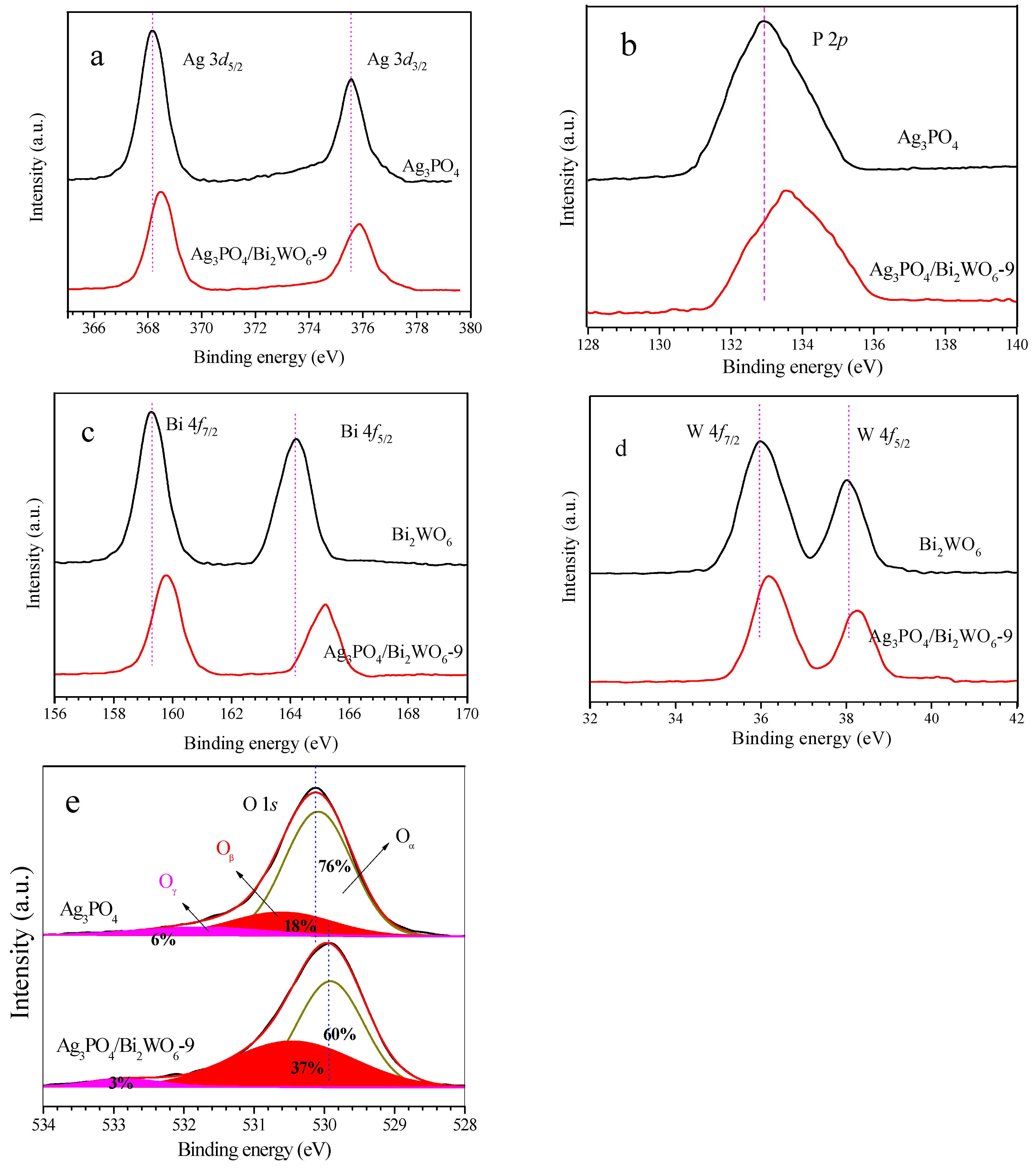
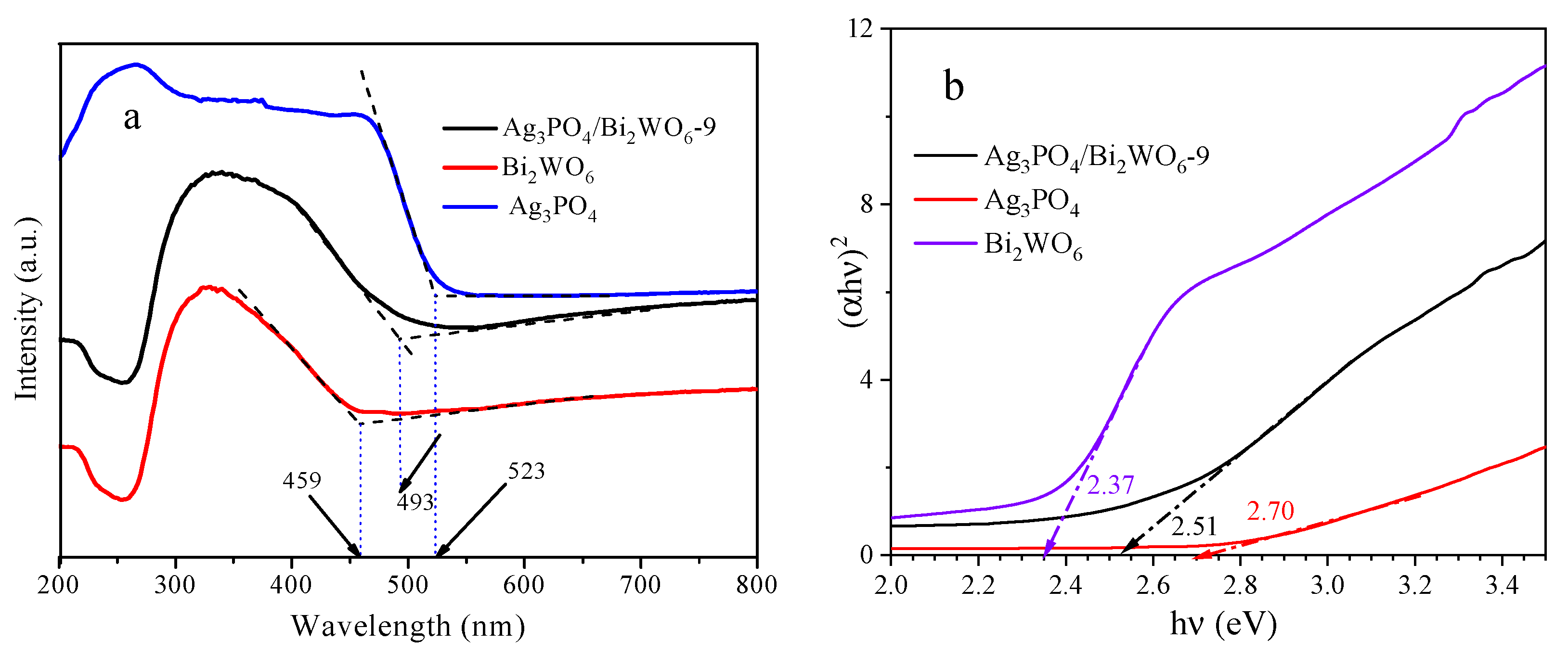
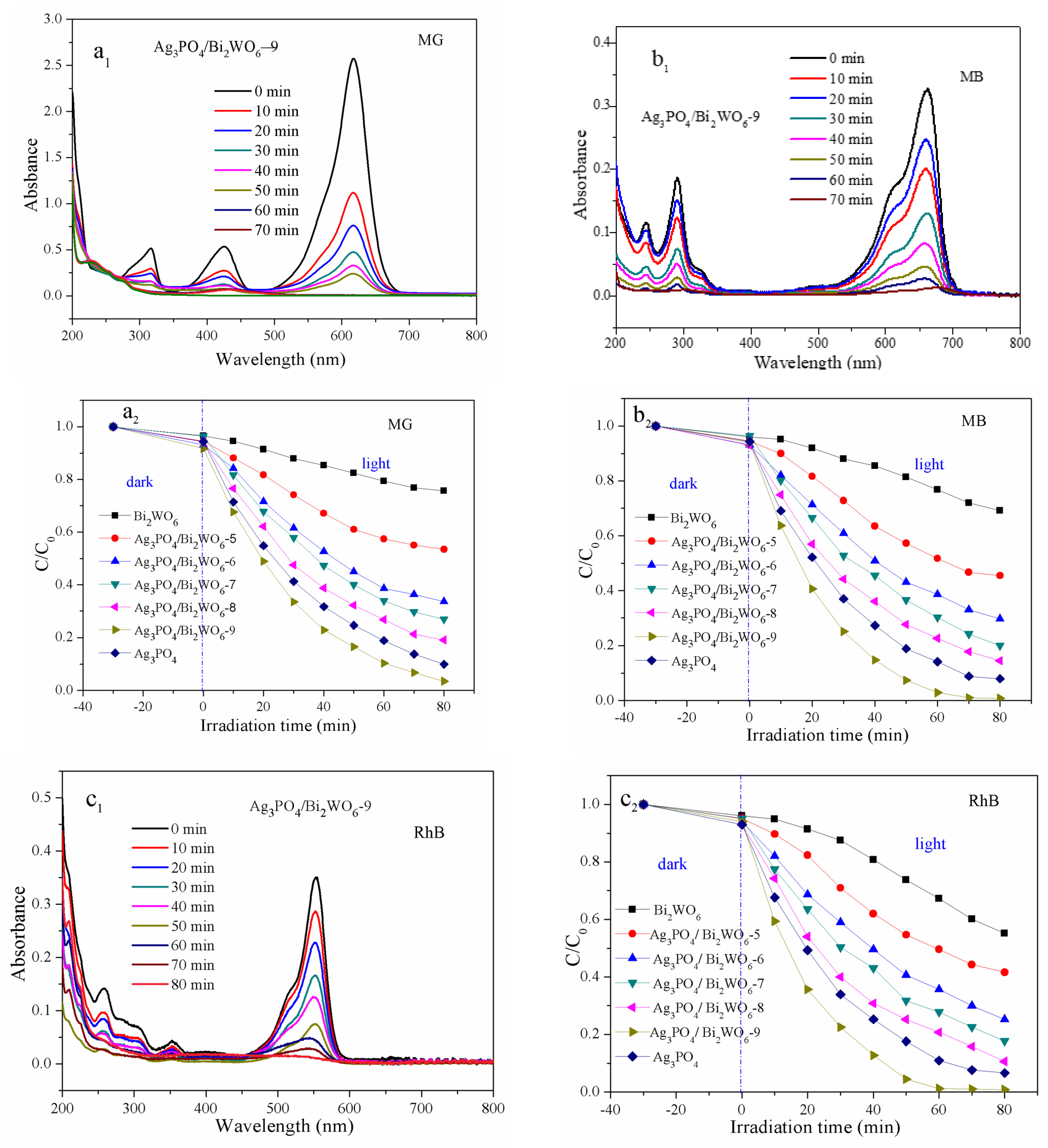
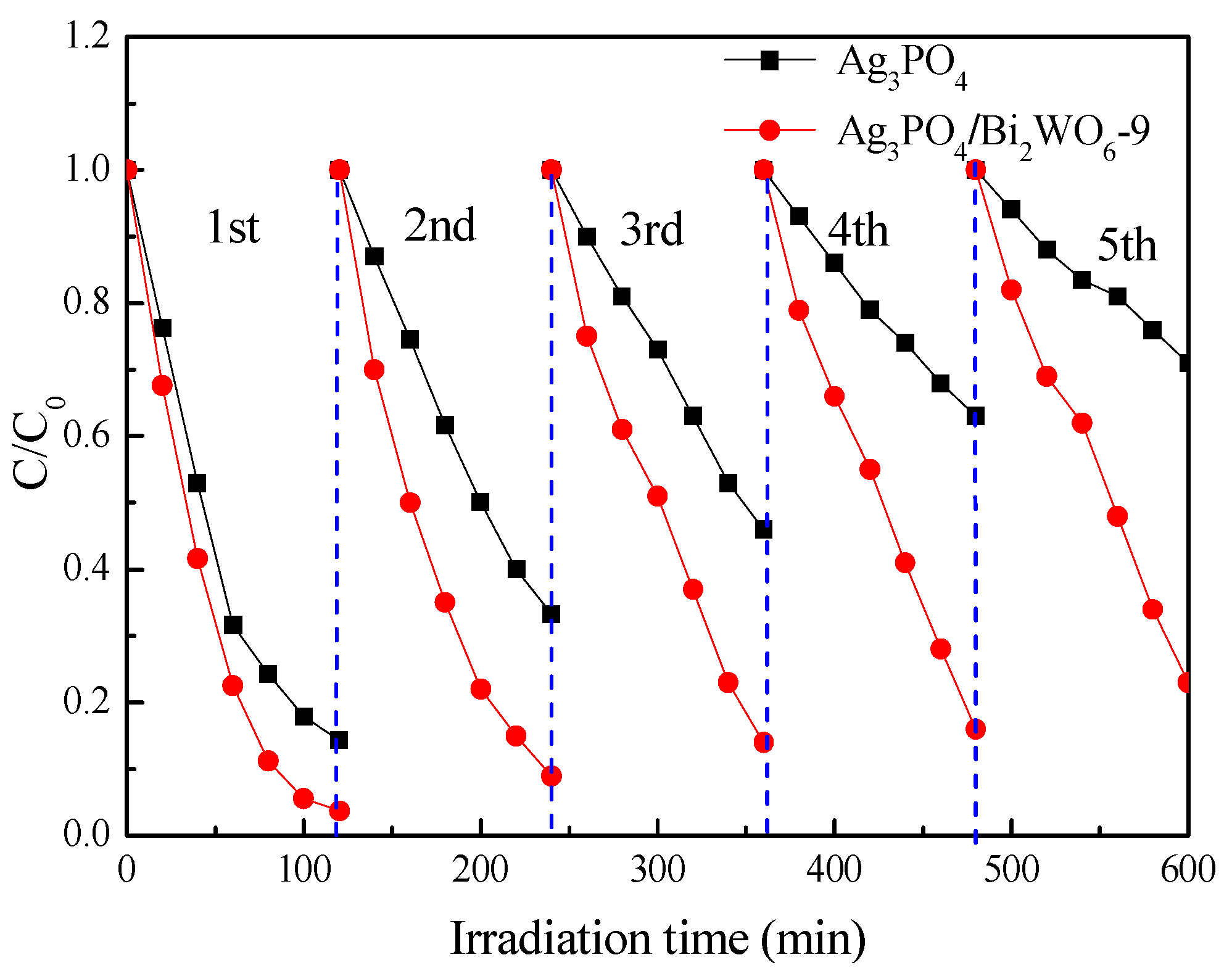

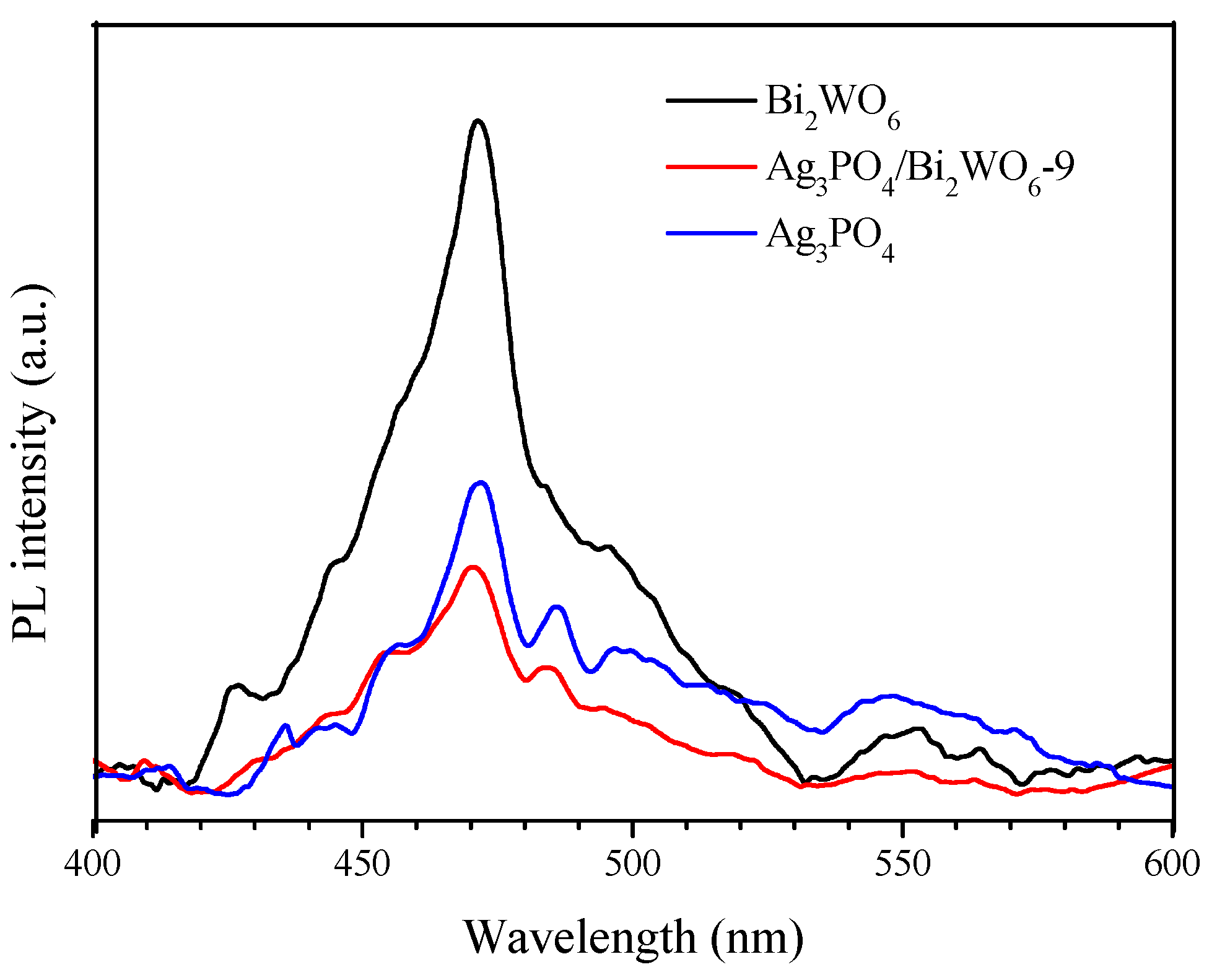
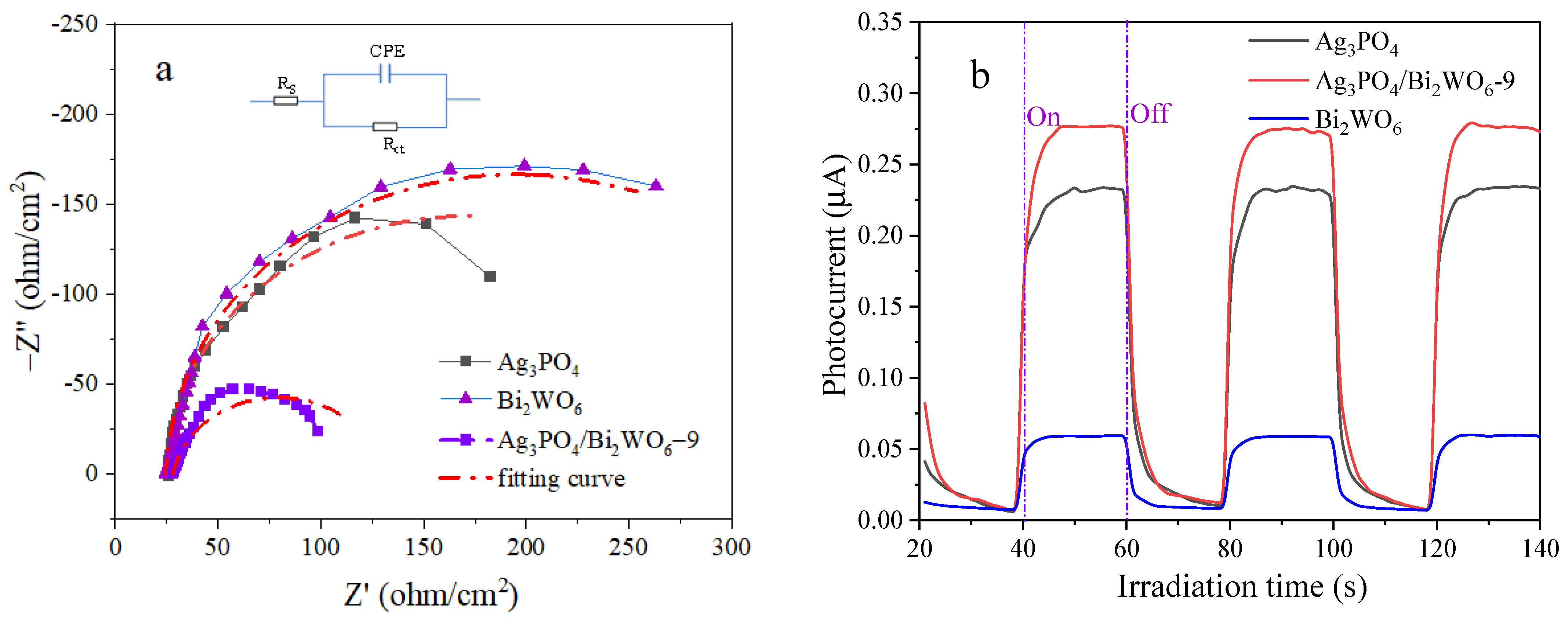

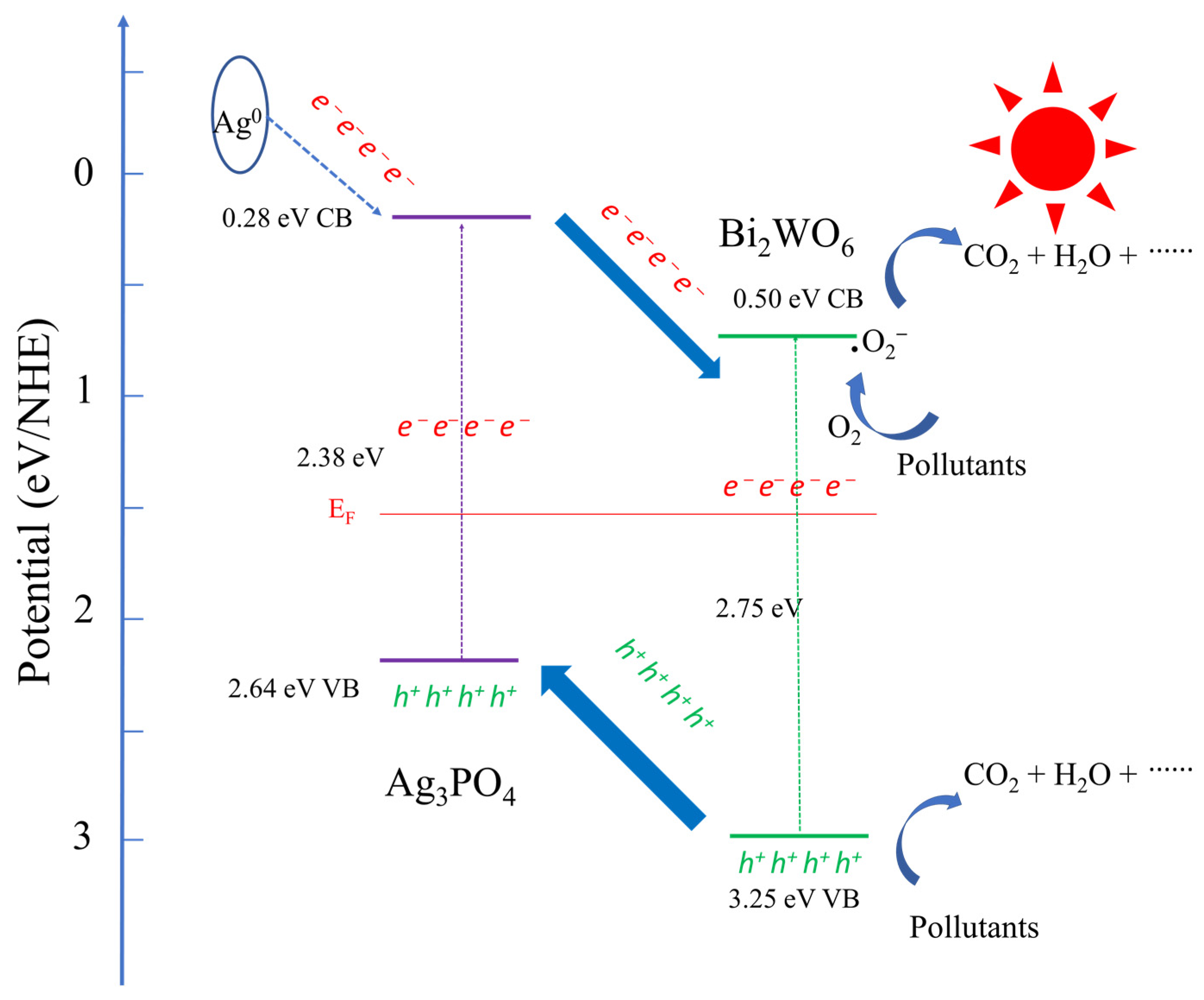
Disclaimer/Publisher’s Note: The statements, opinions and data contained in all publications are solely those of the individual author(s) and contributor(s) and not of MDPI and/or the editor(s). MDPI and/or the editor(s) disclaim responsibility for any injury to people or property resulting from any ideas, methods, instructions or products referred to in the content. |
© 2023 by the authors. Licensee MDPI, Basel, Switzerland. This article is an open access article distributed under the terms and conditions of the Creative Commons Attribution (CC BY) license (https://creativecommons.org/licenses/by/4.0/).
Share and Cite
Wang, L.; Wang, J.; Fei, Y.; Cheng, H.; Pan, H.; Wu, C. Ag3PO4/Bi2WO6 Heterojunction Photocatalyst with Remarkable Visible-Light-Driven Catalytic Activity. Crystals 2023, 13, 1531. https://doi.org/10.3390/cryst13111531
Wang L, Wang J, Fei Y, Cheng H, Pan H, Wu C. Ag3PO4/Bi2WO6 Heterojunction Photocatalyst with Remarkable Visible-Light-Driven Catalytic Activity. Crystals. 2023; 13(11):1531. https://doi.org/10.3390/cryst13111531
Chicago/Turabian StyleWang, Li, Junbo Wang, Yanfei Fei, Heping Cheng, Hua Pan, and Chunfeng Wu. 2023. "Ag3PO4/Bi2WO6 Heterojunction Photocatalyst with Remarkable Visible-Light-Driven Catalytic Activity" Crystals 13, no. 11: 1531. https://doi.org/10.3390/cryst13111531
APA StyleWang, L., Wang, J., Fei, Y., Cheng, H., Pan, H., & Wu, C. (2023). Ag3PO4/Bi2WO6 Heterojunction Photocatalyst with Remarkable Visible-Light-Driven Catalytic Activity. Crystals, 13(11), 1531. https://doi.org/10.3390/cryst13111531



